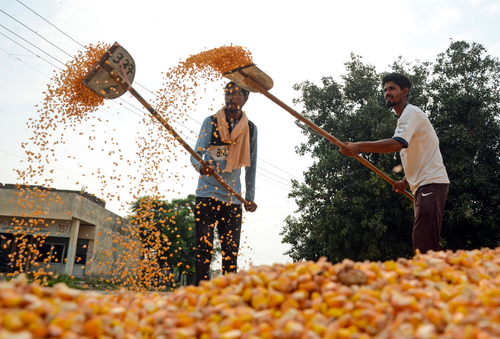New Delhi: The agriculture sector plays a crucial role in the Indian economy as over 47 per cent of the country’s population is dependent on farming for their livelihood. A robust growth in the agricultural sector boosts the incomes of the rural population which accounts for close to 40 per cent of the demand for industrial goods. A high level of agricultural production also keeps inflation in check.
On the other hand, a decline in farm output leads to rising food prices that trigger a surge in inflation resulting in destabilising the economy and hurting overall growth.
The agricultural sector in the country has been a high-priority area for the government and has become increasingly resilient over the years to grow at a steady pace. Climate change, though, has emerged as a formidable challenge with the erratic monsoon adversely hitting crops and bringing down the growth rate in the country’s agricultural output from 3.5 per cent to a mere 1.6 per cent in the July-September quarter of 2023.
The Interim Budget presented by Finance Minister Nirmala Sitharaman gives a major thrust to stepping up value addition in the agricultural sector and boosting farmers’ incomes.
The interim budget’s aim to achieve ‘atmanirbharta’ (self-reliance) in oilseeds such as mustard, groundnut, sesame, soybean, and sunflower can turn out to be a game-changer in boosting the agricultural sector and driving up the overall growth rate of the economy.
The Finance Minister said in her speech that investments lined up for the sector will cover research for high-yielding varieties, widespread adoption of modern farming techniques, market linkages, procurement, value addition, and crop insurance.
India imports around two-thirds of its requirement of edible oils which entails an outgo of a whopping Rs 1.38 lakh crore in precious foreign exchange. The self-reliance in oilseeds would help to conserve this drain and also help to keep the country’s trade deficit under control which would pave the way for a stronger rupee.
The budget allocates Rs 1.27 lakh crore for various schemes to be implemented in the agricultural sector. In addition, Rs 1.64 lakh crore has been allocated for the subsidy to provide fertilisers at a low cost to farmers.
Mentioning the steps being taken to ensure efficient fertiliser use, the Finance Minister mentioned the successful adoption of Nano Urea, and the policy to expand this Nano DAP for various crops in all agro-climatic zones.
Sitharaman also said that private and public investment would be further promoted in post-harvest activities including aggregation, modern storage, efficient supply chains, primary and secondary processing and marketing and branding to ensure faster growth of the agriculture and food processing sector.
Currently, India is deficient in cold storage facilities of perishable goods and estimates put post-harvest losses that could be avoided 30 per cent to 40 per cent in the case of fruits and vegetables.
Terming farmers as “our Annadata”, Sitharaman stated that the minimum support prices for the farm produce are being periodically increased appropriately and direct financial assistance is being provided to 11.8 crore farmers every year under PM-KISAN SAMMAN. Besides, crop insurance is being given to four crore farmers under PM Fasal Bima Yojana.
The Pradhan Mantri Formalisation of Micro Food Processing Enterprises Yojana has assisted 2.4 lakh self-help groups and 60,000 individuals with credit linkages.
The Finance Minister added that other schemes are complementing the efforts for reducing post-harvest losses and improving productivity and incomes. She pointed out that Pradhan Mantri Kisan Sampada Yojana has benefitted 38 lakh farmers and generated employment for 10 lakh people.
The Finance Minister also said that the Electronic National Agriculture Market has integrated 1,361 mandis, and is providing services to 1.8 crore farmers with a trading volume of Rs 3 lakh crore. “These and the provision of basic necessities have enhanced real income in rural areas. Their economic needs could be addressed, thus spurring growth and generating jobs.”
India is the world’s second-largest producer of wheat, rice and sugar, but the government has been forced to restrict exports of these commodities to rein in rising domestic prices as the erratic monsoon adversely impacts farm production.
India is the world’s largest rice exporter and has been ensuring food security in countries across Asia, Africa and the Middle East. The ban on exports has, therefore, impacted food availability in these nations as well.
India’s agricultural exports are expected to drop by $4 billion to $5 billion this year. Senior government officials, however, are optimistic. Rajesh Agarwal, an Additional Secretary in the Commerce Ministry, is of the view that growth in exports of other farm commodities will offset the export deficit this year.
“If we remove agricultural commodities such as wheat and rice, whose exports are controlled, other food exports are growing by over 4% and will make up for the $4 billion to 5 billion gap,” Agarwal told journalists.
Data from the Agricultural & Processed Food Products Export Development Authority (APEDA) show exports of meat and dairy, cereal preparations, and fruits and vegetables, rose between April and November this year.
The Finance Minister is optimistic in her outlook ahead. “The agriculture sector is poised for inclusive, balanced, higher growth and productivity. These are facilitated by farmer-centric policies, income support, coverage of risks through price and insurance support, promotion of technologies and innovations through start-ups,” she said in her budget speech.
–IANS


Comments are closed.